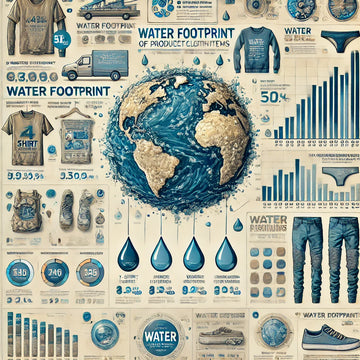The Importance of Sustainable Fashion in Today’s World
by Muhammad Aman on Aug 14, 2024

Sustainable fashion is more than just a passing trend; it represents a fundamental shift in the way we produce, consume, and dispose of clothing. As the global fashion industry faces mounting criticism for its environmental impact and unethical labor practices, the push towards sustainability has never been more crucial. This comprehensive blog will delve into the importance of sustainable fashion, examining its environmental, social, and economic impacts, while providing insights into how individuals and businesses can contribute to a more sustainable future.
Environmental Impact of the Fashion Industry
Water Consumption and Pollution
The fashion industry is one of the largest consumers of water globally. Cotton, a primary material in clothing, requires vast amounts of water to grow. For instance, producing one cotton t-shirt can consume up to 2,700 liters of water. Moreover, the dyeing and finishing processes for textiles are highly water-intensive and often lead to significant water pollution. Toxic chemicals used in these processes are frequently discharged into rivers and lakes, harming aquatic ecosystems and contaminating water supplies.
Carbon Emissions
The fashion industry is responsible for about 10% of global carbon emissions. This significant carbon footprint stems from the energy-intensive production of synthetic fibers, the extensive use of fossil fuels in textile manufacturing, and the transportation of garments across the globe. Fast fashion, characterized by rapid production and low-cost clothing, exacerbates the problem by encouraging overconsumption and frequent disposal of clothing items.

Textile Waste
The rise of fast fashion has led to an exponential increase in textile waste. In the United States alone, an estimated 85% of all textiles end up in landfills each year. Globally, this amounts to millions of tons of clothing waste annually. Synthetic fibers, which are prevalent in fast fashion, can take hundreds of years to decompose, contributing to long-term environmental pollution.

Social and Ethical Impacts
Labor Practices
The fashion industry has long been criticized for its exploitative labor practices. Many garment workers, particularly in developing countries, are subjected to poor working conditions, low wages, and long hours. Child labor and forced labor are also prevalent issues within the industry. Sustainable fashion seeks to address these issues by promoting fair labor practices, including fair wages, safe working conditions, and the elimination of child and forced labor.

Fair Trade and Ethical Certifications
Brands that commit to sustainable practices often seek Fair Trade and other ethical certifications. These certifications ensure that products are made under fair labor conditions and that workers receive fair compensation. Supporting Fair Trade-certified brands helps promote ethical labor practices and supports the economic development of communities involved in garment production.

Community Empowerment
Sustainable fashion also focuses on empowering communities. Many ethical fashion brands invest in community development projects, provide education and training for workers, and support local artisans. This empowerment not only improves the livelihoods of workers but also fosters sustainable economic growth within their communities.

Economic Benefits of Sustainable Fashion
Longevity and Quality
Sustainable fashion emphasizes quality over quantity. While sustainable garments may have a higher upfront cost, they are often made with superior materials and craftsmanship, resulting in longer-lasting clothing. This longevity reduces the need for frequent replacements, ultimately saving consumers money in the long run.

Innovation and New Business Models
The shift towards sustainability has spurred innovation within the fashion industry. Brands are developing new materials, such as biodegradable fabrics and recycled fibers, and adopting innovative business models, like clothing rental services and resale platforms. These new approaches not only reduce environmental impact but also open up new revenue streams and market opportunities.
Consumer Demand and Market Growth
Consumer awareness and demand for sustainable fashion are growing. More people are seeking out brands that align with their values and are willing to pay a premium for ethically produced clothing. This shift in consumer behavior is driving market growth and encouraging more brands to adopt sustainable practices.
How to Embrace Sustainable Fashion
Conscious Consumerism
One of the most effective ways to support sustainable fashion is through conscious consumerism. This involves making mindful purchasing decisions, such as buying fewer, higher-quality items, supporting ethical brands, and prioritizing second-hand and vintage shopping.
Supporting Ethical Brands
Research and support brands that prioritize sustainability and ethical practices. Look for certifications such as Fair Trade, GOTS, and B Corp, which indicate that a brand meets high environmental and social standards.
Caring for Your Clothes
Proper care can significantly extend the life of your clothing, reducing the need for replacements and minimizing waste. Follow care instructions, wash clothes less frequently, use cold water, and line dry when possible. Repair and alter garments instead of discarding them.
Recycling and Upcycling
When your clothes reach the end of their life, consider recycling or upcycling them. Many brands offer recycling programs where you can return old garments. Upcycling involves creatively repurposing old clothing into new items, such as turning a worn-out t-shirt into a reusable shopping bag.
The Future of Sustainable Fashion
Technological Innovations
The future of sustainable fashion will likely see significant advancements in technology. Innovations such as lab-grown leather, biodegradable fabrics, and smart textiles embedded with sensors to monitor wear and tear are set to revolutionize the industry. These technologies can help reduce environmental impact and extend the life of garments.
Circular Fashion Economy
A circular fashion economy aims to eliminate waste by keeping products and materials in use for as long as possible. This involves designing garments for longevity, encouraging recycling and upcycling, and implementing take-back programs. The circular economy model promotes a closed-loop system where nothing is wasted.
Policy and Regulation
Governments and organizations are increasingly recognizing the need for sustainable fashion and are implementing policies and regulations to promote sustainable practices. These include extended producer responsibility (EPR) policies, which make manufacturers responsible for the entire lifecycle of their products, and incentives for companies that adopt sustainable practices.
Consumer Education and Advocacy
Consumer education and advocacy play a crucial role in driving the sustainable fashion movement. By raising awareness about the environmental and social impacts of the fashion industry, consumers can make more informed choices and advocate for change. Education campaigns, workshops, and social media initiatives can all help spread the message of sustainability.
The Imperative of Sustainable Fashion
Sustainable fashion is not just an option; it is an imperative for the future of our planet and society. By addressing the environmental, social, and economic impacts of the fashion industry, sustainable fashion offers a path towards a more ethical and responsible future. Embracing sustainable fashion means making conscious choices, supporting ethical brands, and advocating for systemic change. Together, we can transform the fashion industry into a force for good, ensuring that it respects both people and the planet.
By understanding the importance of sustainable fashion and taking actionable steps, we can all contribute to a more sustainable world, one garment at a time.

